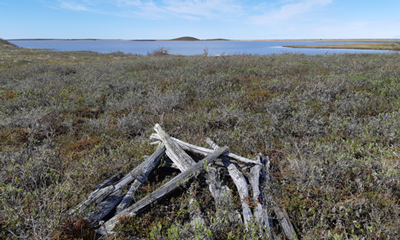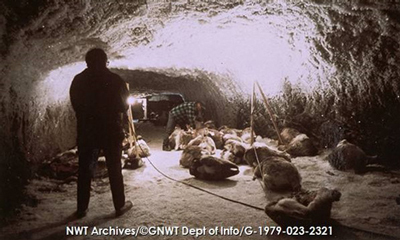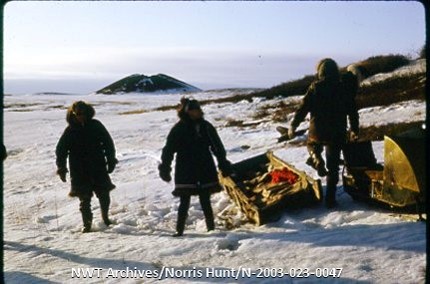
Aerial view of an old reindeer corral in the niaquq (head) area of Qikiqtaryuuyaq (Nicholson Island), 1995 (NWT Archives/Northwest Territories. Department of Education, Culture and Employment fonds/G-2004-004: 0544).
History and Culture
Pingo Canadian Landmark
Reindeer herding at The Pingo Canadian Landmark
In the early 1900s, the Inuvialuit noted that the caribou herds they depended on in the western Arctic were decreasing in size and no longer following predictable paths. In the vast landscape, the odds of a good caribou harvest were decreasing and Inuvialuit hunters needed to travel longer distances in search of caribou. To address this issue the Canadian government decided to introduce reindeer from Alaska to the Mackenzie Delta area in 1935. The reindeer had originally been brought to Alaska from Siberia in 1892 and 1898.
After an arduous five-year drive from Western Alaska, 2370 reindeer arrived east of the Mackenzie Delta, between Inuvik and Tuktoyaktuk. Sami herders, from a reindeer-herding culture indigenous to Scandinavia, came from Norway. They educated the local people on herding and training sled reindeer for transporting people and supplies.
In 1950, a reindeer corral was established in the area that is now The Pingo Canadian Landmark. It was considered a good location because of the abundance of driftwood for building a corral and for using as fuel. Reindeer were rounded up in corrals for harvest, as well as to count, castrate, tag and provide medical care to the reindeer.
Wallace Lucas and Peter Rufus formed a partnership as managers of Herd No. 2 and became the first independent Inuvialuit owners of a reindeer herd. At the time, 1099 reindeer were part of Herd No. 2. People helping Lucas and Rufus out with their reindeer herd established at least 2 camps within the boundaries of the landmark. At camp, people lived in double-walled tents and used wood stoves for heat.
Traces of the reindeer-herding history can still be seen in the archaeology sites that remain. Reindeer husbandry moved on from the landmark a short while later when it turned out the bay was too shallow for boats. The following year, Lucas and Rufus built a new corral a few kilometres west in the Qiniqsiq area.
The cultural landscape
There are many Siglitun place names along the coast and inland areas. Siglitun is a dialect of the Inuvialuktun language. Place names serve a number of functions. People use them as navigational aids in reciting or noting the names to help mark the progress of their journey. For example, Tuktuuyaqtuuq, Ibyuk, Kilutqusiaq, Qiniqsiq, Naparutalik, Kangianiq, and Anagguvik are a few examples of names along the coast that people may recite when travelling past area of the landmark. Place names also embody information, such as what resources were in an area at the time of naming, or they tell of legends or other cultural events.
The Inuvialuktun place names within the landmark are Ibyuk (singular) and Kilutqusiaq. The 2 largest pingos were traditionally known as Ibyuk. Ibyuk means "thick," and refers to the thick moss or ground found on the outside of the pingos. Today, only the largest pingo is known as Ibyuk. Many of the pingos have English names.
Pingos as landmarks and lookouts
The land along the coast of the Beaufort Sea and in the vicinity of The Pingo Canadian Landmark is low and featureless in many places. Any geographical feature that breaks the horizon serves as a nakataq (landmark). The larger pingos make excellent landmarks throughout the year. They stand out in the distance and help people know where they are when they are travelling on the ocean and inland.
A larger pingo serves as a good lookout, or nasisaqturvik, because it is often the highest point around. People may use them to look for game, for other travellers, or to check the condition of the sea ice.
Hunting blinds
Hunting blinds are locally known as “hideouts” or talut in Siglitun. Hunters construct hideouts using the driftwood found in abundance along the coastal beaches. Sometimes, hunters use willows as hideouts in places that lack driftwood, such as in dry lakes. In addition to using hideouts, hunters often wear white parka covers to prevent geese from seeing them.
Tuktoyaktuk elder, Noah Felix, spoke about the use of hideouts in a July 2000 interview:
[There] are lots of hideouts [along] this beach . . . I used to hunt [here] when I was younger. I used the same place, and it’s the same good place. That was 30 or 40 years ago . . . The geese still use it . . . they always seem to go by there. Maybe because of the hill [pingo], or maybe the wind is just right for them, or they like the place.

A hideout or talut (Parks Canada)

Two men and caribou carcasses inside a tunnel in a pingo, used as a meat freezer in Tuktoyaktuk. Date: Unknown (NWT Archives/Northwest Territories. Department of Information fonds/G-1979-023: 2321)
Harvesting at the landmark

Pingo in background [There are a snowmobile, a komatik and 3 people in the foreground.]. Date: [1968?] (NWT Archives/Norris Hunt fonds/N-2003-023: 0047)
Cotton grass serves a number of important functions to Inuvialuit. Cotton is part of the fire-starting kit and is used to catch and hold a spark. A spark was once made by striking a flint against a piece of pyrite, or later, a file or some other iron object. Seed heads can also be collected and twisted into wicks for a family’s stone or clay lamp.
Berries are abundant in many places within the landmark and have always been important to the Inuvialuit as a nutritious and delicious food. Lingonberries (Vaccinium vitis-idaea), locally known as cranberries, have pink flowers that develop into bright red, seedless berries by late August.
The white flowers of cloudberries (Rubus chamaemorus) come out in June while the orange berries ripen in late July. Historically, people stored cloudberries under moss in birch bark baskets, where the permafrost prevented them from spoiling in the heat or from freezing too hard in the winter.
Blueberries (Vaccinium uliginosum) are also found at the landmark. Blueberry stems and leaves can be boiled to make a tea for cold symptoms. Additionally, it’suh, a traditional dessert made from pounded dry fish, is prepared with cranberries or blueberries.
Visitors are not allowed to pick berries within The Pingo Canadian Landmark boundaries.
- Date modified :